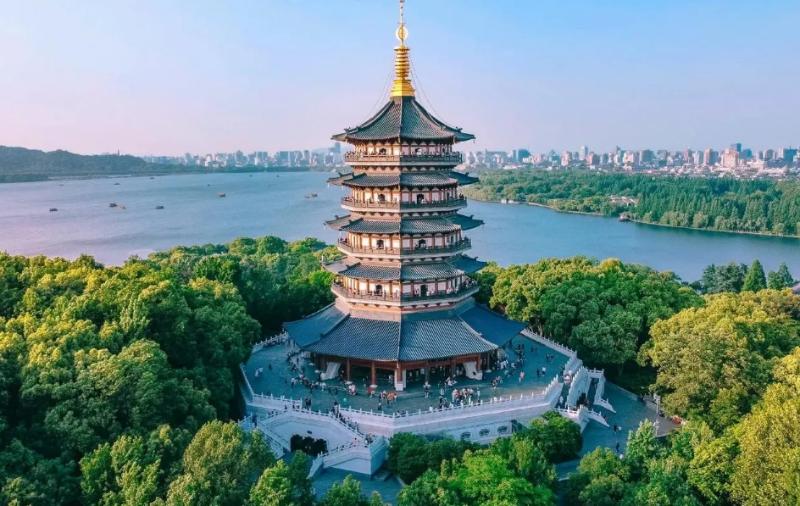Leifeng Pagoda

Leifeng Pagoda: A Landmark of West Lake
Standing proudly on the southern shore of West Lake, Leifeng Pagoda is a unique landmark of Hangzhou City and a masterpiece of ancient Chinese architecture. It not only boasts a rich history but also carries countless legends and stories, attracting countless visitors to experience its unique charm.
I. History and Legends
1. Historical Origins
- Leifeng Pagoda was initially built during the Five Dynasties and Ten Kingdoms period by King Qian Shu of Wuyue for his beloved consort, Lady Huang, and was originally named "Huangfei Pagoda" (Empress's Pagoda).
- At the time, Leifeng Pagoda was the tallest structure in Hangzhou City, standing approximately seven stories tall, with an octagonal structure, intricate design, and imposing grandeur.
- It housed Buddhist relics and valuable artifacts, making it one of Hangzhou's most iconic landmarks.
2. Legendary Tales
- Leifeng Pagoda is intricately linked to the legend of the White Snake, with people believing that the love story of Bai Suzhen and Xu Xian unfolded beneath the pagoda.
- Legend has it that Bai Suzhen, after stealing a magical herb, was suppressed by the monk Fahai beneath Leifeng Pagoda, eventually transforming into a white snake to protect the pagoda.
- This legend adds a mystical aura to Leifeng Pagoda, making it a symbol of love and faithfulness.
3. Historical Transformation
- Leifeng Pagoda underwent numerous renovations and rebuildings, but was destroyed by fire during the late Ming Dynasty.
- In 1924, the site of Leifeng Pagoda was designated as a provincial-level cultural relic protection unit.
- In 2002, the reconstructed Leifeng Pagoda was officially opened to the public, becoming another renowned attraction of West Lake.
II. Architectural Features
1. Pagoda Structure
- The reconstructed Leifeng Pagoda adopts an ancient architectural style, with an octagonal structure, seven stories, and a height of approximately 71 meters.
- Inside the pagoda, a staircase allows visitors to ascend to the top, offering panoramic views of West Lake.
- The pagoda is adorned with intricate decorations and delicate carvings, showcasing the exquisite craftsmanship of ancient artisans.
2. Building Materials
- The main structure of the pagoda is made of reinforced concrete, with the exterior decorated with blue bricks and stone, harmonizing with the ancient architectural style.
- Some parts of the interior are made of wooden structures, using traditional construction techniques.
- The choice of building materials ensures both structural safety and durability, while maintaining the authentic style of Leifeng Pagoda.
3. Meaning and Symbolism
- As a symbol of Buddhist temples, Leifeng Pagoda is a place for people to pray and make wishes, representing peace and good fortune.
- The octagonal structure symbolizes eight directions of auspiciousness, and the seven stories represent the seven levels of enlightenment, reflecting the Buddhist cultural connotation.
- The reconstructed Leifeng Pagoda is not only a masterpiece of ancient architecture but also a testament to modern construction technology, showcasing the inheritance and innovation of Chinese architecture.
III. Cultural Value
1. Historical and Cultural Value
- Leifeng Pagoda is a significant testament to Hangzhou's history, reflecting the city's development and transformation.
- The pagoda houses numerous historical artifacts, providing valuable materials for future generations to study ancient history and culture.
- Leifeng Pagoda is a masterpiece of ancient architectural art, embodying the essence and characteristics of ancient Chinese architecture.
2. Literary and Artistic Value
- Leifeng Pagoda has been the subject of many literary works, such as the legend of the White Snake and "Leifeng Sunset."
- The legends and stories surrounding Leifeng Pagoda have ignited people's imagination, leading to the creation of numerous captivating literary works.
- The beautiful scenery of Leifeng Pagoda has attracted countless artists to create, leaving behind many exquisite works of art.
3. Tourism Value
- Leifeng Pagoda is a renowned attraction of West Lake, drawing visitors from around the world every year.
- Climbing to the top of Leifeng Pagoda offers panoramic views of West Lake, allowing visitors to appreciate the beauty of the lake.
- The legends, stories, and architectural features of Leifeng Pagoda provide visitors with a unique tourism experience.
IV. Conclusion
Leifeng Pagoda is not only a dazzling landmark of West Lake, but also a masterpiece of Chinese traditional culture and architectural art. It carries history and legends, showcases exquisite and magnificent architecture, and attracts countless visitors to experience its unique charm. Standing atop Leifeng Pagoda, gazing out at the breathtaking scenery of West Lake, one cannot help but marvel at the passage of time and the profoundness of culture, while also looking forward to a bright future.